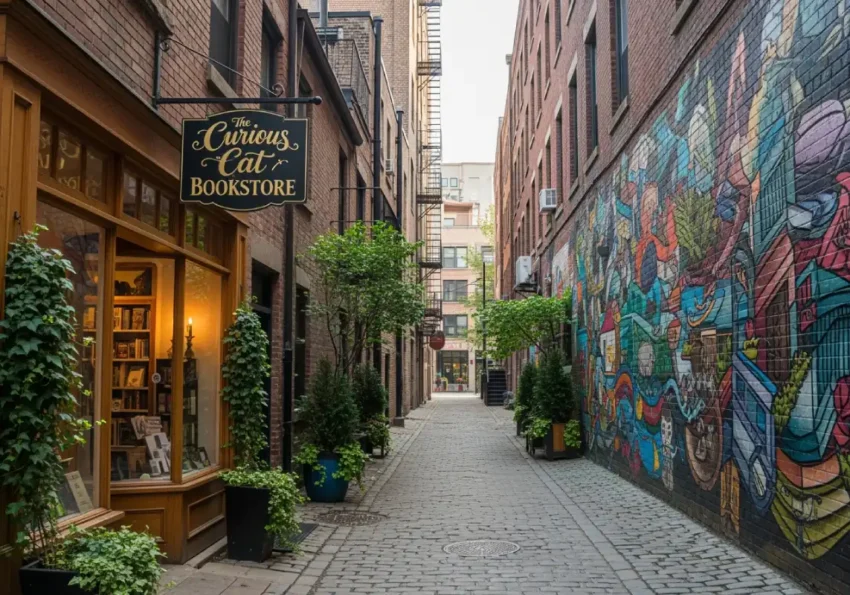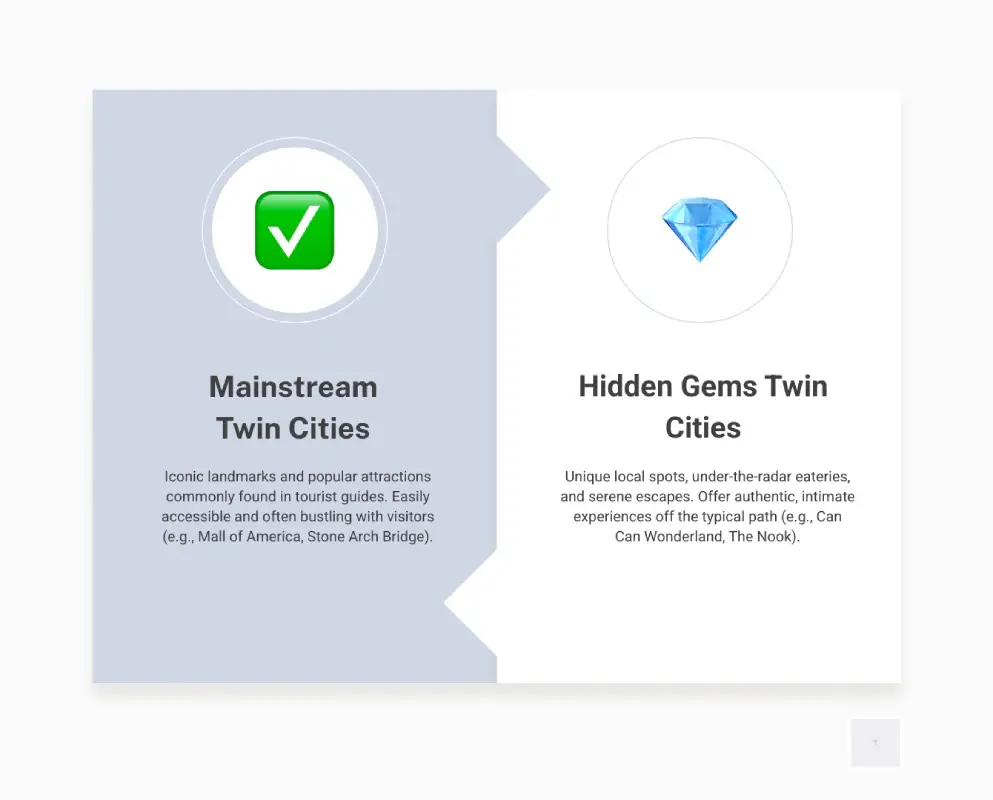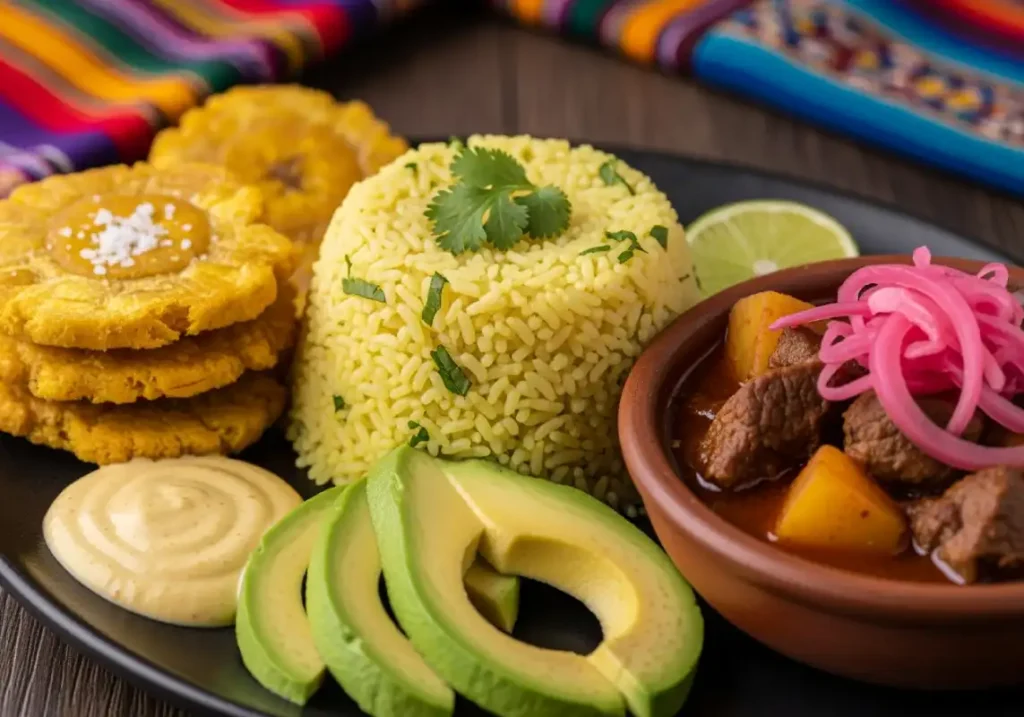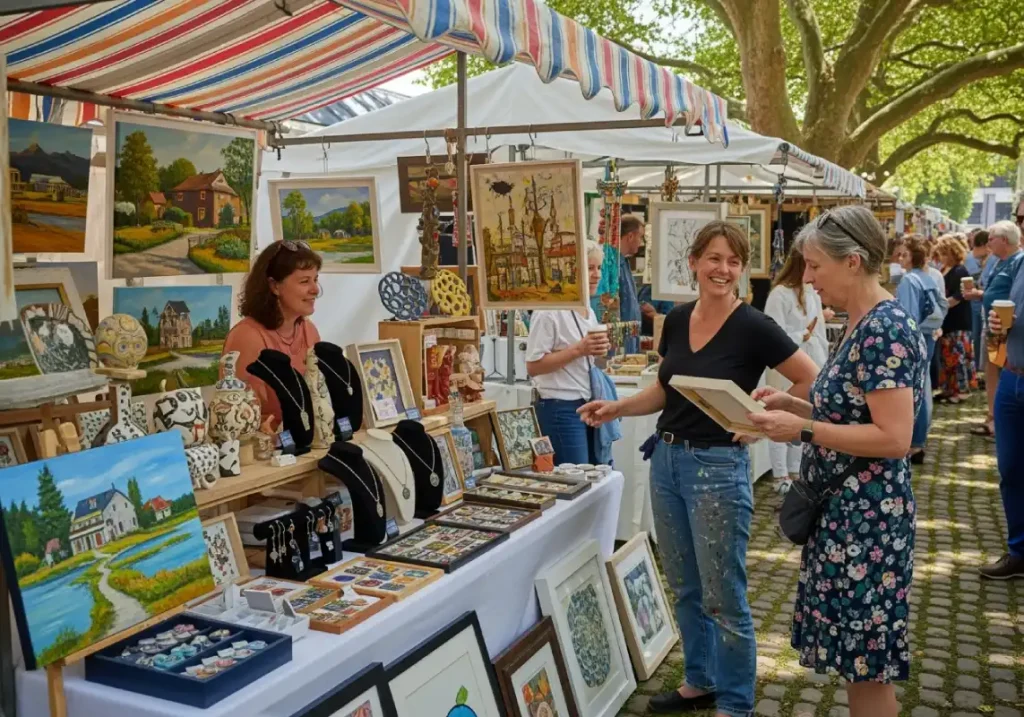Off the Beaten Path in the Twin Cities—Hidden Gems Await!

The Twin Cities of Minneapolis and St. Paul are celebrated for their vibrant cultural scene and picturesque landscapes. However, many of their most captivating experiences remain beyond the well-trodden tourist paths. These hidden gems offer a unique and authentic glimpse into the region’s rich character and creative spirit.
This article invites readers to venture off the beaten path. It guides them through a curated list of unique attractions, under-the-radar eateries, and serene natural escapes. Find the places locals cherish and that truly define the Twin Cities.
Visitors will uncover quirky museums, secret speakeasies, and unexpected outdoor adventures. Each spot reflects this dynamic metropolitan area’s distinct history, diversity, and inventiveness. Additional resources can further improve your exploration for a comprehensive Twin Cities hidden gems directory.
The Twin Cities boast a remarkable array of attractions that often fly under the radar, offering visitors a chance to experience something unique. From interactive art spaces to museums dedicated to forgotten technologies, these spots provide a refreshing alternative to mainstream tourist destinations.

Quirky Attractions and Unusual Museums
One of the most vibrant and whimsical hidden gems is Can Can Wonderland in St. Paul. This former canning factory has been transformed into an artist-designed indoor mini-golf course with vintage arcade games, pinball machines, and live entertainment. Each mini-golf hole is a unique, imaginative creation by a local artist, making it an interactive art gallery as much as a recreational activity.
Beyond the golf, visitors can enjoy craft cocktails, a tap wall, and food, creating an all-encompassing entertainment experience. It’s a place where creativity and play converge, offering an out-of-the-ordinary weekend adventure.
For those fascinated by the history of communication, the Pavek Museum in St. Louis Park is a must-visit. This museum features over 12,000 square feet of historic radio and television equipment, allowing visitors to return quickly. Guests can explore antique radios, learn about the evolution of broadcast technology, and even play a Theremin – an instrument famously played without physical contact. The Pavek Museum offers a hands-on journey through the airwaves, appealing to history buffs and curious minds.
In South Minneapolis, the House of Balls is a testament to eccentric artistry. This unique gallery and workshop space, created by local artist Allen Christian, features sculptures made from salvaged materials like bowling balls, mannequin parts, and industrial scraps. The participatory atmosphere invites visitors to engage with the art and contribute to the changing collection. It’s where “getting lost among old things is a great way to find yourself,” offering a truly one-of-a-kind artistic immersion.
Another intriguing stop is The Bakken Museum, nestled on the shores of Lake Calhoun. While it explores the history of electricity and magnetism, it does so with a distinct quirkiness, featuring artifacts related to Frankenstein, medical quackery, and early scientific instruments. It’s a “mini museum” that offers a fascinating blend of science, history, and the slightly bizarre, making it an engaging educational experience for all ages.
For a different perspective on the city, the Foshay Observation Deck provides panoramic views from the 30th floor of the historic Foshay Tower in Minneapolis. Completed in 1929, the Foshay Tower was once the tallest building in Minneapolis. Beyond the stunning vistas, the 27th floor houses a historic speakeasy, Prohibition Bar, offering a taste of the past alongside contemporary cocktails. It’s an excellent spot to appreciate Minneapolis’s skyline and architectural heritage.
Finally, a truly eye-catching hidden gem is the World’s Largest Lite-Brite Mural at Union Depot in St. Paul. Measuring an impressive 12 feet by 24 feet, this colossal artwork brings a nostalgic childhood toy to life on an epic scale. It’s a vibrant, colorful display that captures the imagination and serves as a delightful, unexpected piece of public art in a historic transportation hub.
Under-the-Radar Eateries and Speakeasies
The Twin Cities’ culinary scene extends far beyond its well-known restaurants, with numerous hidden eateries and secret bars offering distinctive flavors and atmospheres.
In St. Paul, The Nook is legendary for its “Juicy Lucys” – a cheese-stuffed burger that rivals any in the city – and its unique ambiance. This eatery is located in a basement and combines a classic diner feel with subterranean bowling lanes. The walls and ceiling are famously adorned with over $16,000 worth of one-dollar bills stapled by patrons, creating a quirky, immersive environment. It’s where “things are just better below grade,” offering great food and an unforgettable setting.
For a taste of delicate sweetness, Thirty-Six Café in Minneapolis offers exquisite soufflé pancakes. Founded by Hmong-American Macy Lee, inspired by Thai honey toast, the café serves fluffy, cloud-like pancakes in unique flavors like Classic, Lemon Blueberry, and Mango Sticky Rice. It’s a labor of love, with Macy perfecting her recipe over extensive testing. The café also features a beautiful, hand-designed floral décor, making it a delightful spot for brunch.
Venturing into international flavors, Chimborazo brings authentic Ecuadorian cuisine to the Twin Cities. This under-the-radar spot is a “sleeper hit,” offering dishes rarely found locally, such as llapingachos (potato patties) and other Andean specialties. It provides a genuine taste of South America, showcasing the Twin Cities’ diverse culinary landscape.
For those seeking a more clandestine drinking experience, a Secret Uptown speakeasy in Minneapolis offers an old-world setting with award-winning classic cocktails. This hidden bar emphasizes its discreet nature, providing patrons with an exclusive and intimate atmosphere. It’s the kind of place you need to know about to find, adding an element of intrigue to your night out.
Another unique bar experience is the Clown Lounge at the Turf Club in St. Paul. Tucked beneath the historic Turf Club music venue, this basement bar is known for its quirky, slightly eerie clown-themed decor. It’s a dive bar with character, offering a distinct alternative to more polished establishments and often serving as a pre- or post-show hangout for concert-goers. As one local put it, it “may be a must-see or somewhere to avoid for the rest of your life,” depending on your taste for the unusual.
Finally, Norseman Distillery in Northeast Minneapolis combines craft spirits with a lively community hub. Beyond its excellent array of distilled products, Norseman hosts unique weekly events like “BUNGO” (a twist on bingo with a local celebrity host) and “Trivia Mafia” nights. They also serve Flat Iron Pizza and offer non-alcoholic mixers made with fresh-pressed juices, making it a versatile spot for drinks and entertainment.

3 Must-Try Dishes from Hidden Eateries:
- The Juicy Lucy from The Nook: A classic, cheese-stuffed burger that’s a Twin Cities staple.
- Soufflé Pancakes from Thirty-Six Café: Light, fluffy, and beautifully presented, especially the Mango Sticky Rice flavor.
- Llapingachos from Chimborazo: Authentic Ecuadorian potato patties, a true taste of the Andes.
Exploring the Twin Cities Local Gems
Beyond the urban core, the Twin Cities metro area offers numerous natural escapes and unique outdoor experiences that provide tranquility and adventure.
Unique Outdoor Escapes and Natural Wonders
The Mississippi National River and Recreation Area is a remarkable 72-mile, 54,000-acre federally protected corridor that winds directly through the Twin Cities. This urban national park offers extensive hiking, biking, fishing, and boating opportunities, allowing residents and visitors to connect with the majestic Mississippi River. Many overlook this vast natural resource, which provides serene river trails and stunning overlooks within the metropolitan area.
Minnesota also boasts a network of Scientific and Natural Areas (SNAs), largely undeveloped public lands that preserve rare plants, animals, and geological features. Many of these are deliberately unmarked, making them true hidden gems.
One example is Pine Bend Bluffs in Inver Grove Heights, which offers dramatic river views and protects a unique ecosystem. Exploring SNAs often requires research and a sense of adventure, but the reward is encountering pristine natural beauty. These areas are vital for conservation, and their quiet, untouched nature starkly contrasts with the busy city.
While Minnehaha Falls is a well-known landmark, many visitors visit the main viewing areas. However, the surrounding Minnehaha Park offers numerous less-crowded trails that wind along Minnehaha Creek, leading to smaller, picturesque cascades and quiet spots perfect for reflection. Exploring these hidden paths reveals this popular park’s different, more intimate side, allowing for a deeper connection with nature.
Big Island Nature Park offers a fascinating blend of natural beauty and forgotten history on Lake Minnetonka. Once the site of an amusement park in the early 1900s and later a veterans’ camp, the island now serves as a serene nature preserve. Visitors can explore trails that wind through lush forests, find remnants of the old amusement park, and enjoy panoramic lake views. It’s a tranquil escape that tells a story of change and resilience.
In St. Paul, High Bridge Park provides stunning views of the Mississippi River and the city skyline. This park is also home to the Giant Green Chair, a 2,500-pound sculpture created as part of a youth employment initiative. The chair offers a playful, oversized photo opportunity and a unique landmark within the park, encouraging visitors to explore the area’s natural beauty and public art.
Offbeat Shops and Cultural Markets
The Twin Cities’ shopping scene is not limited to malls and chain stores; it thrives with unique, independent shops and vibrant cultural markets that offer a treasure trove of unusual finds and authentic experiences.
A true cultural immersion can be found at the Hmong Village Market in St. Paul. Given that Minnesota and Wisconsin have the largest Hmong populations in the country, this market is a unique local food and shopping destination. It’s a busy indoor marketplace where visitors can find authentic Hmong cuisine, fresh produce, traditional clothing, and various goods. It’s an essential stop for experiencing the rich Hmong culture through its vibrant commerce and delicious food.
Similarly, the Midtown Global Market in Minneapolis is a dynamic indoor public market that celebrates diversity through food and artisan crafts. It features over 40 businesses representing more than 22 cultures, offering everything from Mexican tacos and Indian curries to African art and Latin American groceries. It’s a sensory delight and a testament to the Twin Cities’ multicultural fabric.
For those who love to browse for the wonderfully weird, Ax-Man Surplus Store is a Twin Cities institution. Described as the “Costco for items no one really needs,” Ax-Man offers an ever-changing inventory of surplus goods, gadgets, scientific equipment, novelty items, and general oddities. It’s a place where you never know what you’ll find, making every visit an adventure in findy.
The Center for Lost Objects in St. Paul is another fascinating destination for unique finds. This shop specializes in vintage items, upcycled art, and curiosities, offering a curated collection of forgotten treasures. It’s a haven for collectors and anyone looking for a distinctive piece with a story.
Finally, Architectural Antiques in Minneapolis is a grand warehouse filled with salvaged architectural elements from historic buildings. From stained glass windows and ornate fireplace mantels to vintage hardware and reclaimed wood, it’s a paradise for renovators, designers, and anyone who appreciates the beauty of old craftsmanship. “Getting lost among old things is a great way to find yourself,” here, as you wander through aisles of history.
Distinctive Neighborhoods and Historic Streets
Beyond individual attractions, specific neighborhoods and streets in the Twin Cities possess a special character and history that visitors often overlook.
St. Anthony Main in Minneapolis is one of the city’s oldest and most picturesque neighborhoods. With its cobblestone streets, historic brick buildings, and stunning views of the Mississippi River and the Stone Arch Bridge, it feels like a step back. It’s a charming area for a stroll, offering unique shops, restaurants, and a glimpse into Minneapolis’s industrial past.
In St. Paul, Cathedral Hill is renowned for its magnificent Victorian architecture and tree-lined streets. Centered around the iconic Cathedral of Saint Paul, this neighborhood exudes historic charm and elegance. It’s perfect for a walking tour, admiring the grand mansions and enjoying the upscale boutiques and cafes that dot the area.
West Seventh in St. Paul, often called “Fort Road,” is a working-class neighborhood with a strong local identity. It’s known for its historic pubs, local breweries, and diverse eateries, offering an authentic St. Paul experience away from the more touristy areas. It’s a great place to sample local craft beers and enjoy a hearty meal in a friendly, unpretentious setting.
Eat Street (Nicollet Avenue) in Minneapolis is a vibrant corridor bursting with international flavors. Stretching for several blocks, this street is home to an incredible array of ethnic restaurants, from Vietnamese pho and Ethiopian stews to Mexican taquerias and Middle Eastern kebabs. It’s a culinary journey worldwide, offering diverse dining experiences for every palate. For a comprehensive list of hidden gems and local favorites across these neighborhoods, a detailed Twin Cities hidden gems directory can provide invaluable guidance.

Finding the Best Twin Cities Local Gems
To truly experience the Twin Cities’ hidden gems, it is key to embrace local advice and utilize the city’s excellent infrastructure.
Locals are often the best source for uncovering these secret spots. Don’t hesitate to talk with a barista, bartender, or shop owner; their recommendations can lead to memorable findies.
The light rail system is an efficient way to travel between Minneapolis and St. Paul, connecting many key areas and making it easier to access hidden spots without the hassle of parking. For a more active exploration, biking the extensive Greenway trails or simply exploring on foot allows for serendipitous discoveries in neighborhoods like St. Anthony Main or along the riverfront.
The Twin Cities also host unique seasonal events that are considered hidden gems. While some are well-known, others offer a more niche appeal. For instance, the Cat Video Festival, which has been held at places like CHS Field, is an unexpectedly popular and quirky event that celebrates feline internet stars.
Another fantastic event is Art-A-Whirl in Northeast Minneapolis, the country’s most extensive open studio tour. During this annual event, artists open their studios to the public, offering a chance to meet creators, see their work, and purchase unique pieces directly. It’s a vibrant celebration of the Twin Cities’ thriving arts community.
Finding the Twin Cities’ hidden gems is about embracing the unexpected and allowing for spontaneity. These places reflect the history, diversity, and creativity that define Minneapolis and St. Paul, offering experiences that are both unique and deeply authentic. Visitors can uncover the true heart and soul of this dynamic metropolitan area by venturing off the beaten path.



